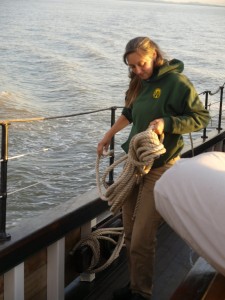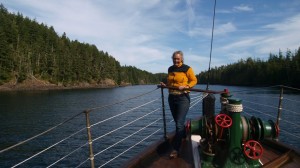Most people who are thinking about cruising in the Inside Passage already have the skills, techniques and ability to handle a boat. In other words, they are practiced in seamanship. To cruise to Alaska, there are several areas of seamanship that you need to feel comfortable with, and which I’ve already covered in this series.
In my previous articles I’ve written about planning, outfitting, electronics, charts, tides and currents. This week, I’m going to focus on crew communications since that is an important part of cruising, and one that is dear to me, because I’m crew and I rely on my captain to make me look good.
While it may be your dream to cruise the Inside Passage, it might be that your crew is going along because they’re to married and you. I’ve run into countless couples where one member was not so jazzed about their adventure, and finds it is a strain on their relationship. I think that’s a shame since cruising in the Inside Passage can and should be a fantastic experience for everyone on board.
Crew Communications:
It’s important to have a good way to answer the crew’s questions and to understand why they are asking them. I got into boating much later than Jeffrey, and I ask a lot of “dumb” questions that are a result of some level of fear due to the lack of understanding. What makes Jeffrey a good seaman and someone who is good to work with is that he has the patience to listen to the question. He thinks about his answer, but also why I’m asking it before giving me an explanation. This approach has not only helped me as a boater, but also it has strengthened our relationship because I have trust in him that he won’t ridicule my ignorance.
Tip: F.E.A.R – False Expectations Appearing Real. This is what is going on in your crew’s head. They are afraid of something that you are about to do because their perception is uneducated and the conclusions that they are drawing are causing them anxiety. If you can explain away their misconceptions, then you’ve erased your crew’s F.E.A.R
Departing Docks:
When we leave the dock, we have a standard routine, but I always check to see if there is anything different Jeffrey wants me to do. The routine includes what order the dock lines are untied and where I’m going to step onto the boat. Sometimes, he wants me in the bridge to learn or sometimes he wants me to keep a fender ready because the wind or current might have an unusual effect on the boat. Most days I’d probably end up in the right spot based on my own experience, but I feel it’s always best to quickly confirm the details of our departure.
Tip: Have a routine for leaving the dock, but make sure that you confirm with your crew that you’ll be using it. Don’t be afraid to change the routine when needed, but if you do, walk your crew through your expectations.
Anchoring:
Sometimes anchoring or bringing up the anchor can be stressful on both crew and captain. If you’re coming into a new place, your crew is most likely nervous. They want to do the right thing and they don’t want you yelling at them. That embarrasses them and builds resentment. Several minutes before coming to an anchorage it’s a good idea to talk with your crew about the anchorage, what it looks like on the chart, and where you plan to drop the hook. This gives your crew time to ask questions and calm any fears. If there is something that concerns you about your anchorage, such as the number of boats, crab pots or depth, share that with your crew. It’s helpful to you for them to know your concerns. ???When I’m on deck waiting for Jeffrey’s signal to drop the anchor, I keep my eyes open for unmarked submerged objects and crab pots. If we are not using 2-way radios to talk to each other, I’ll indicate objects using a set of hand signals that we’ve developed to help us avoid potential problems.
Tip: If you trust your crew to help you steer around objects like mooring buoys or crab pots, the hand signals can be used to tell you which way to turn, otherwise the hand signals should just be for the crew to point to the obstacles. Either way, make sure you know what they mean when they signal to you.
Most days when we bring up the anchor it’s straight forward. The chain comes up and the anchor goes into the hawes hole, but then there are other days when communication between the captain and crew is vital. Sometimes the wind or the current has the potential to move the boat into a dangerous situation. If we know that this will be a possibility we’ll have a chat so I know what to expect, and how long I might need to run the windlass before Jeffrey can safely maneuver the boat. Talking with your crew not only helps them feel comfortable and in control of your situation, but it also gives you a chance to think out loud about your plan which helps you make sure that it is sound.
Communications When Underway:
When someone new takes the helm, they need to know what’s going on. On big ships there’s a very formal way of doing this. Our system isn’t so formal, but it includes, where we are on the chart, what our heading is, and information on boats that are in our vicinity and if they are going to have an affect on our course. We talk about potential underwater hazards and if there is anything else in sight that could pose a problem. We also talk about where the other is going and how long to expect to be at the wheel. Remember you’re trying to make sure that your crew member cannot fail.
Arriving at a Dock:
Many crew members on other boats have confided in me that coming to a dock is the worst part of their boating experience. After talking with several people, I’ve come to believe that it’s because there’s no trust between captain and crew, and each other’s ability. Crew is often unsure of the captain’s skill in maneuvering the boat, and the captain is unsure of the crew’s ability to fend, get lines to the dock, and relay important information. This has the potential to be an emotionally explosive situation.
Over the years, Jeffrey and I have developed a set of docking routines that we use depending on the dock. Most of our docking is done with a spring line that Jeffrey uses to suck the boat to the dock. The David B have bow or stern thrusters so he relies on subtle techniques to get me to the dock safely so I can step off and tie my spring line. For 90% of our docking we use a starboard-side tie with the spring line technique. If that’s not possible, we discuss how he’s hoping to get the boat to the dock and what he’s expecting that I’ll do. He also gives me extra instructions for his concerns if it looks like we’re facing a tight fit. That said, there’s always a chance that something unexpected will happen and we might have to make last minute changes.
Good Samaritans are non-crew members that have the potential to pop up at any dock. These are well meaning people who might be able to help, but they can also spell disaster for your most perfect docking ever. In general, I like to have Good Samaritans standby in case we need assistance. A Good Samaritan who asks to help is an asset and can be quickly informed of your plan. It’s good to practice what to say to Good Samaritans so that you can give clear directions.
Tip: Have a plan for Good Samaritans. If you choose to use a stranger on the dock, be sure that you or your crew can communicate clearly so that you’re not distracted by their help and you remain in control of the docking.
It takes little effort to communicate. Make plans ahead of time and share them will your crew. A well informed crew is not likely to embarrass you by doing something wrong and unpredictable. Remember they are just trying to do the right thing. Involve your crew by sharing information. Crew members are often unsure of themselves and need to know what you know. If you inform them about what you expect while they are at the wheel or getting ready to tie the boat to a dock, they’ll respond in a predictable manner which will make you the envy of all the other boaters around you.
Next week we’ll be talking about the Rules of the Road and how they affect you in the Inside Passage.


